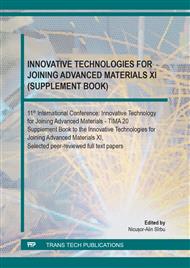p.3
p.9
p.17
p.25
p.35
p.47
p.55
p.67
p.77
Considerations about Hollow Polypropylene Balls Manufacturing by Ultrasonic Welding
Abstract:
Fast development of Sustainability and Circular Economy concepts has been materialized in European Parliament Directive no 2019/904. This Directive requires to reduce the consumption of plastic material for the manufacture of disposable packaging. In spite of the aggressive campaign against plastic materials usage, there are huge advantages which must be considered before replacing them by other alternative materials. Downsizing, Lightweighting and Downgauging technics are employed from early stage in designing new products made by plastic materials. Product recyclability features and recycled materials usage for products manufacturing need also to be assessed during the design and testing phase. This article proposes ultrasonic welding as an alternative technology for manufacturing the hollow polypropylene balls. With the traditional technology, the manufacturing of these balls results in an uneven wall thicknesses and a large technological runner of material that needs to be grinded and reintroduced into the injection equipment and this involves high consumption of raw material and energy. The proposed method of manufacturing these hollow balls consists in forming the ball from two ball halves joined together by ultrasonic welding. This process will result in significant savings in raw material and energy. As a case study, the manufacturing of deo roll balls have been considered. Several experimental researches have been made using ultrasonic welding at frequencies of 20 kHz and 35 kHz. Significant improvements on the capabilities of the ball external diameters have been recorded by ultrasonic welding using the frequency of 35 kHz. Further testing and comparative study of mechanical properties must be considered in order to define the best process parameters for hollow plastic balls manufacturing by Ultrasonic Welding.
Info:
Periodical:
Pages:
35-45
Citation:
Online since:
June 2021
Price:
Сopyright:
© 2021 Trans Tech Publications Ltd. All Rights Reserved
Share:
Citation:


